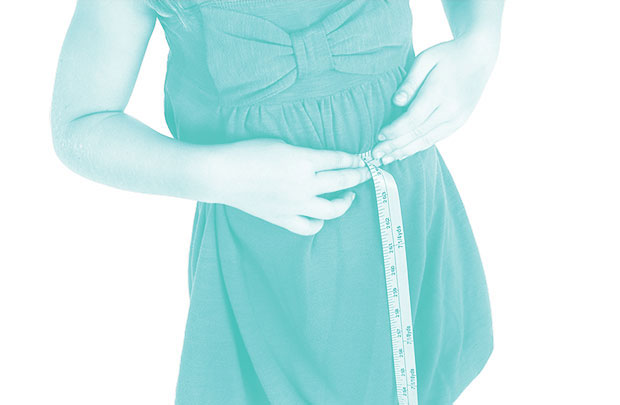As a general rule of motherhood, there’s little disagreement that what it means to worry isn’t truly defined until you’re tasked with taking care of a little person all your own, and being in charge of his or her health and wellness. And by “worry,” we mean gut-wrenching, sweating, heart-pounding anxiety.
Once you’ve made it through the uncertainty of infancy and toddlerhood, there’s a whole new host of health concerns as your kids head toward their tweens and teens. We talked to some of the area’s leading experts to compile a guide of the latest (sometimes surprising) facts about the biggest health issues facing children and how to troubleshoot, in the hopes of letting us all sleep a little better at night.
1. Allergies & Asthma

Never heard of an allergic march? No, it’s not a stroll outside at the height of pollen season. Instead, envision your child embarking on a long walk (called life) and picking up one allergy at a time as she goes on. It’s not that improbable, considering that many kids with one allergy are more likely to develop others. Here’s how the allergic march looks in childhood (though asthma and allergies—even those involving food—can pop up at any age).
➜ If both parents have allergies, their child has a 75 percent chance of having allergies, too.
➜ About 20 percent of infants develop eczema.
➜ Approximately 37 percent of them have an underlying food allergy (most commonly wheat, dairy, egg, peanut, or soy).
➜ 20 percent of children with eczema go on to develop a peanut allergy by age 3.
➜ 80 percent of these children will remain allergic for life.
➜ Nasal allergies such as hay fever affect as many as 40 percent of children.
➜ 9.3 percent of children have asthma (the third-ranking cause of hospitalization in children).
➜ 80 percent of kids with asthma have allergies.
2. Body Image 101

“Parents have a huge impact on their children’s body image and eating behaviors from day one,” says Eleanor Mackey, PhD, assistant professor, of psychiatry and behavioral sciences at George Washington University. “The more you help your children appreciate themselves for who they are and their bodies for what they can do and teach them to take care of themselves, the less likely it is that they will develop problems later.”
➜ Talk about the F-word.
Welcome to one of your first difficult conversations with your child. As soon as your child adds “fat” to his or her vocabulary, explain why a word like that can be hurtful and why it shouldn’t be used. For example, “People come in all shapes and sizes, which is a good thing! Every body can do fantastic things. Sometimes, though, words can be hurtful. Talking about what someone looks like can hurt people’s feelings even if you don’t mean to.”
➜ Keep the focus on what your child’s body can do.
“Look at your strong legs! They help you run so fast.” “I love the way you drew that picture—your brain is so imaginative!” When you take the time to point out to children how their bodies help them do amazing things, rather than saying, “You’re so pretty,” it sends a message that you (and they) value their abilities and health rather than their appearance.
➜ Make “diet” a positive concept from day one.
While your child is under age nine, start with, “Most people just need to eat a healthy diet with lots of fruits, vegetables, proteins, and good grains to take the best care of their body.” As he or she gets older, try, “Sometimes people change what they eat in order to feel healthier, get stronger, or change their body size. It is important to always be healthy, and we let our doctors help us decide what is best to take care of our body.”
➜ Practice what you preach.
“It won’t do a whole lot of good if parents praise their child’s abilities, persistence, healthy behaviors, and what their body can do while that same parent complains he or she is fat, talks about trying to lose weight, or has a negative self-image,” says Mackey.
3. Eye Spy

We asked DC’s Dr. Michael P. Rosenblatt, OD, what he wished all parents knew about their child’s vision. Here are his five essential questions, answered.
➜ Are there any red flags that can alert you to a problem?
Since children don’t necessarily know what “normal” vision looks like—or when it’s off—it’s important for parents to watch for signs of a problem, such as unusual postures when doing visual tasks. Are they sitting too close to the TV or reading material? Is there constant eye rubbing, poor focus, and squinting? If your child has had any trauma in and around the eyes, see an eye-care provider ASAP. Retinal tears and detachments do occur in children and are one of the most common causes of preventable blindness.
➜ Is there an easy test a parent can do to test a child’s vision?
Cover one eye at a time while the child views something. If one eye has really poor vision and you have covered the “good” eye, the child will move to avoid your hand because the visual world has been taken away.
➜ At what age can a child get contact lenses?
I generally feel comfortable fitting kids between ages 8 and 12 with contact lenses. I tend to recommend daily disposable lenses, like 1-Day Acuvue Moist, because kids are worse than adults at managing the daily cleaning process and taking them out at night, and could end up with a serious eye infection.
➜ What’s a common mistake that can hurt kids’ eyes in the long run?
Anytime children are outside, even if it’s cloudy, they should be shielding their eyes from UV radiation. This means wearing a hat and wrap-around sunglasses. Those who wear contacts should choose a brand with UV protection.
➜ What else can we do to protect our kids’ vision?
Recent reports have shown an increase and earlier onset of myopia (nearsightedness) in children, and that’s been linked to use of hand-held devices. Another study found that spending time outdoors significantly reduced the onset of myopia in children compared with those who did not partake in outdoor activities. My advice: Get your child a soccer ball and put away the electronics.
4. That’ll leave a mark.

Maryland-based cosmetic surgeon Dr. Nia Banks gives us the 411 on childhood scars.
➜ What’s the best way to minimize scarring after an injury?
Scarring is worsened by inflammation. Keep the wound clean with soap and water to reduce the risk of infection, but avoid using peroxide and alcohol, as these slow down healing. Use ice in the first 24 to 48 hours to reduce swelling.
➜ Are there any products that can reduce scarring?
Silicone sheeting is an over-the-counter product that helps soften and flatten scars. Massaging scars and keeping them moist is always good for wound healing. But it’s best to wait until the wound has sealed before you start these treatments; 48 hours is the minimum for most cuts.
➜ Can you ever fully erase a scar?
You can never eliminate scarring—it’s a normal part of the healing process. But children heal amazingly well, better than adults. Their skin has a higher moisture content and more collagen, and is more elastic. Scars take a year or more to mature fully, so a scar will look progressively better for some time. You can have a cosmetic surgeon repair the wound or do a scar revision later if you have any concerns.
5. 3 Things You Didn’t Know About Tummy Aches

➜ The cause can be determined by where the pain is.
“We divide the pain as above or below the belly button,” explains Dr. Robynne Chutkan, a DC-based gastroenterologist and the author of Gutbliss. Above affects the upper gastrointestinal tract, and pain is often caused by eating too much dairy or rich fat, or just eating too late in the evening. Lower-tummy problems are usually in the colon, and the most common cause is plain old constipation. “Parents are often surprised to hear this because they’re feeding their child a whole-wheat bagel in the morning and whole-wheat pasta for dinner. That’s not a substitute for the fiber in vegetables, and it’s keeping their kids’ plumbing from working right,” says Chutkan.
➜ A quick fix usually isn’t.
While giving your child an occasional laxative isn’t a big deal, do so very selectively. “I’m appalled to see the rise in suppositories and MiraLax, which contains the same stuff that’s in antifreeze!” says Chutkan. “You need to examine what you’re doing on a daily basis, not just stick a Band-Aid on it.” Same goes for many of the probiotic yogurt drinks aimed at kids, which Chutkan says provide the same bacterial benefits as licking the floor.
➜ Aches may not be all about the tummy.
A recent study found that children with chronic or recurring stomach pain without a clear medical explanation were more likely to have an anxiety disorder. Additional research also shows that talk therapy may help kids with frequent and unexplained stomach pain. More than half of kids and teenagers who met weekly with a therapist had their stomach aches lessen or go away within a year.
6. The New Science of Sleeping

Ideal Sleep Timing
Ages 4 to 5 ➜ Bedtime between 6 and 8, depending on whether the child is still napping. Total of 11 to 12 hours.
Ages 6 to 8 ➜ Bedtime between 7:30 and 8:30. Total of 10 to 11 hours.
Ages 9 to 12 ➜ Bedtime between 8:30 and 9:30. Total of 10 to 11 hours.
Ages 13 to 18 ➜ Bedtime at 11. Total of 9 hours.
“We now know that every cell in the body has clock genes that regulate all cell functions. When they’re not coordinated, there’s a breakdown in bodily functions,” says Dr. Danny Lewin, PhD, director of the sleep disorders medicine program at NIH’s National Center on Sleep Disorders Research. “If your kids aren’t sleeping at the right time for the right amount of time, their body isn’t functioning as it should.”
How bad is it to stray off course?
“There have been studies involving shift workers that show heart attack and stroke risks increasing because they don’t sleep at the optimal times. Yet we’re asking our kids to do the same thing, in part because of school start times,” explains Lewin.
7. Obesity

We’re born knowing exactly when our bellies are full. “Babies naturally know when to stop eating,” says Dr. Nazrat Mirza, a DC-based pediatrician specializing in weight management. “But parents tend to override the satiety center by trying to feed their children what they believe is the right amount for them. As a result, over time, that ability to know when they’ve had enough is gone.”
After kids turn two, we tend to stop asking how much they weigh. Call it getting comfortable in parenthood, but suddenly you don’t even bother asking your pediatrician what percentile your child is in. Big mistake. “It’s easier to lose weight when you only have a little to lose, so keeping an eye on it decreases the chances of the weight getting out of hand,” says Mirza. The big thing to watch: Is your child on an uncharacteristic upward trajectory? If he or she has always been in the 50th percentile and is now in the 75th, it’s time to discuss what’s happening.
For kids, not gaining can be as much of a success as losing. “Kids gain height, so if you can help them to stop gaining pounds, you’ll bend the curve,” Mirza says.
By the Numbers
45% ➜ The chance that kids who are overweight at age 5 are more likely to be obese by age 14.
15 to 20 ➜ Number of times your child may have to try a food before developing a taste for it.
51 ➜ Percentage of parents who thought their overweight child was normal or underweight or thought their obese child was normal, underweight, or just overweight (based on 69 studies of more than 15,000 children).
8. 3 Big Myths about ADHD

More than 5.9 million kids suffer from attention deficit hyperactivity disorder, an umbrella term used to describe different types of attention and behavior problems. But the misconceptions about it are still huge. Here’s what you need to know.
➜ Myth: You’ll know if your kid has it by the time he or she is in first grade.
Reality: Some kids with ADHD go undiagnosed all the way to middle school. “If the child doesn’t have the hyperactivity piece, and they’re smart enough to learn through memorization during the early school years, no one realizes there’s a problem until they get old enough for the information they’re learning to require organization and synthesizing,” explains Dr. Adelaide Robb, a Fairfax-based psychopharmacologist specializing in pediatric disorders. “Then they hit a wall, and by that point, their parents or teachers may accuse them of not trying hard enough, which isn’t the case.”
➜ Myth: Girls don’t get ADHD.
Reality: Although it’s more common in boys, almost 5 percent of girls are diagnosed with ADHD. “Unfortunately, instead of identifying the real cause of their issues, these girls are often discounted as not intelligent, or social butterflies who don’t care about academics, or just lazy,” says Robb.
➜ Myth: When kids reach age 12, they outgrow it.
Reality: While hyperactivity can decrease significantly at that point, the inattention and inability to focus persist, making it more difficult than ever to struggle through longer classroom periods and manage long-term assignments such as reports.
9. Brace yourself: 3 Orthodontia Facts

➜ The way your child breathes directly affects the formation of his teeth, bones, jaw, and face.
“When I examine my patients, I especially look at the airway—the mouth, nose, throat, and windpipe—and ask if they snore, have sleep apnea or reflux disease, or grind their teeth,” says Dr. Lynda Dean-Duru, an Ashburn-based pediatric dentist trained in orthodontic management. “Parents don’t realize that these breathing issues can have long-term disfiguring effects, so early intervention is extremely important.”
➜ It’s all about the jaw.
Assuming there are no breathing problems or early bad habits like thumb-sucking, teeth that come in crowded or crooked are actually often resolved without treatment, says Dean-Duru. But if the jawbones are affected, start saving up for braces. The most common examples are underbite—where the lower jaw is too big and the upper jaw too small—and its opposite, the overbite.
➜ Braces at age four? Yes, sometimes.
Jaw issues have a fairly small window of opportunity to change the growth pattern, especially when there’s a family history.
10. Heads Up
“Concussions produce physical, cognitive, and emotional signs and symptoms that can last hours, days, and months,” says Dr. Gerard Gioia, PhD, director of the safe concussion outcome recovery and education (SCORE) program at Children’s National Medical Center in DC. And all the recent media attention on concussions has millions of parents in a full-blown panic. Gioia tells us what we need to know.
➜ Loss of consciousness isn’t necessary for a concussion.
In fact, it happens less than 10 percent of the time.
➜ Early intervention is key.
We hear a lot right now about concussions leading to dementia and other very serious issues, but if managed early and properly, the vast majority of people recover just fine.
➜ Concussions can’t be diagnosed by MRI or CT scan.
A medical professional needs to make the call after a thorough examination of the nature of the blow and symptoms, so make sure you keep track of all pertinent information.
➜ Sports: the best protection you can provide for your child is in how you choose the league, not the actual activity.
“You should ‘interview’ the league just as you would a sitter with whom you’d leave your infant,” says Gioia. “You wouldn’t leave your kids with someone without knowing anything about them other than what you read online; this holds true for sports, too.” One important trait: The league should have a concussion-trained medical professional on site or on speed dial.
Add this to your smartphone
➜ Make sure you recognize all the signs and symptoms of a concussion at a moment’s notice with the free Concussion Recognition and Response app, created by Gioia and Jason Mihalik, PhD. It allows you to complete a quick checklist to determine whether symptoms are serious enough for immediate medical attention. You can also record a child’s vital info (name, age, gender, sport played) and take photos of the injury. The app lets you share this info via e-mail with medical professionals during the treatment process.
Your Turn
Your kids’ health may take center stage, but it doesn’t mean you can let yours fall apart.
“We tend to worry about these big, sudden health emergencies, but the biggest risk factor for moms isn’t cancer falling out of the sky—it’s stress that erodes your health,” explains gastroenterologist Robynne Chutkan. “Studies have actually found that chronic low-grade stress—like the kind you experience taking care of kids every day—is worse than one big stressful event that has a beginning, middle, and end.”
Of all the items on your never-ending to-do list, do not—we repeat, do not—miss your annual primary-care appointment. “It’s important to find—and stay with—a doctor you trust and relate to,” says Chutkan. “There’s no substitute for a good going-over and a well-informed conversation since these often find hidden illnesses like ovarian cancer or autoimmune disease.”



















